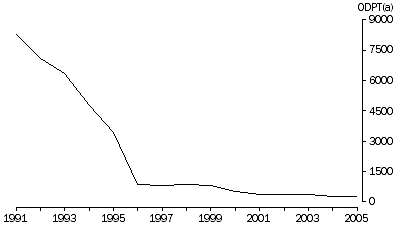OZONE
CONSUMPTION OF OZONE DEPLETING SUBSTANCES
The amount of ozone in the upper atmosphere matters because it absorbs most of the sun's harmful ultraviolet B radiation.
When excessive UV radiation reaches the Earth’s surface it can cause health problems to people and other organisms, including damage to the eyes, skin and immune system. It can also affect crop yields and marine plankton (which might have flow-on effects to many marine ecosystems). Radiation can degrade plastics, wood, paper, cotton and wool.
Certain substances trigger the destruction of ozone. Human activity has been responsible for increasing the concentrations of ozone depleting substances in the upper atmosphere: the main ozone depleting emissions are chlorofluorocarbons (CFCs) used in refrigeration, and halons and methyl bromide, used in many industries. As a result of these emissions, between 2% and 4% of ozone over Australia has been lost each decade since the 1950s, and we are now exposed to greater levels of UV radiation than in the past (1).
Estimates of Australia's total consumption of ozone depleting substances, weighted according to the ozone depleting potential of each, are presented in the graph above. Consumption in 1994 was over 4,700 ozone depleting potential tonnes (ODPTs: an aggregated scale of measurement which allows one to add together quantities of different gases and weights them according to the amount of ozone each could potentially deplete).
In 2005, it had fallen, in response to international restrictions, to 277 ODPTs, composed mostly of hydrochlorofluorocarbons (HCFCs) and methyl bromide.
Australia stopped the importation and production of CFCs during the 1990s, and we are ahead of the Montreal Protocol's schedule in reducing our use of HCFCs, which are the minor ozone depleting substances used as interim replacements for CFCs.
CONSUMPTION OF OZONE DEPLETING SUBSTANCES
 (a) Ozone depleting potential tonnes are an aggregated scale of measurement which allows
the addition of quantities of different gases and then weights them according to the amount of
ozone each could potentially deplete.
Source: Available from the Department of the Environment and Heritage on request.
(a) Ozone depleting potential tonnes are an aggregated scale of measurement which allows
the addition of quantities of different gases and then weights them according to the amount of
ozone each could potentially deplete.
Source: Available from the Department of the Environment and Heritage on request.
ENDNOTES
1. State of the Environment Committee 2002, Australia – State of the Environment Report 2001, CSIRO Publishing, Melbourne.
 Print Page
Print Page
 Print All
Print All